Prognostic Effectiveness Assignment Report
VerifiedAdded on 2022/09/15
|9
|2599
|20
AI Summary
Contribute Materials
Your contribution can guide someone’s learning journey. Share your
documents today.
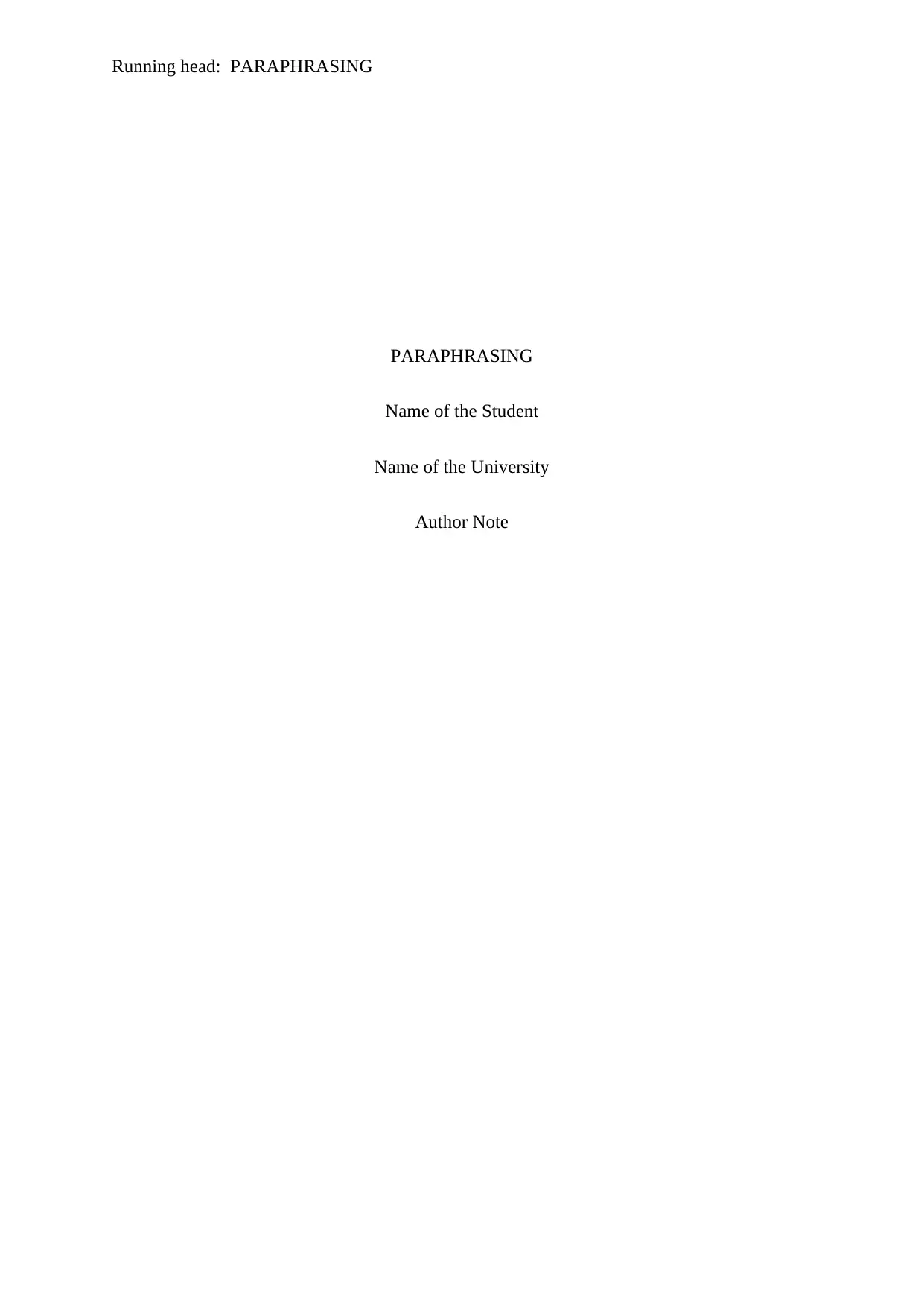
Running head: PARAPHRASING
PARAPHRASING
Name of the Student
Name of the University
Author Note
PARAPHRASING
Name of the Student
Name of the University
Author Note
Secure Best Marks with AI Grader
Need help grading? Try our AI Grader for instant feedback on your assignments.
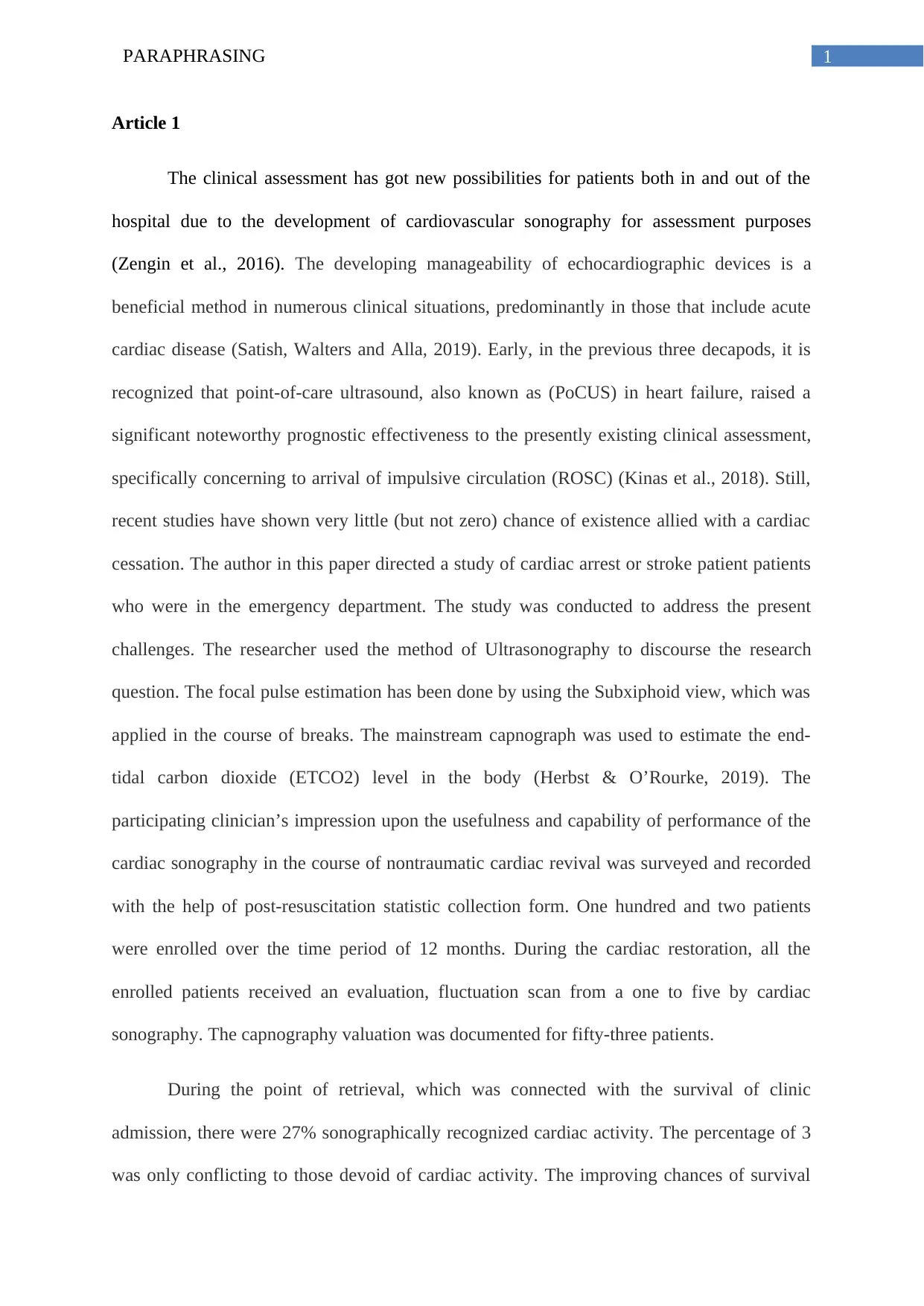
1PARAPHRASING
Article 1
The clinical assessment has got new possibilities for patients both in and out of the
hospital due to the development of cardiovascular sonography for assessment purposes
(Zengin et al., 2016). The developing manageability of echocardiographic devices is a
beneficial method in numerous clinical situations, predominantly in those that include acute
cardiac disease (Satish, Walters and Alla, 2019). Early, in the previous three decapods, it is
recognized that point-of-care ultrasound, also known as (PoCUS) in heart failure, raised a
significant noteworthy prognostic effectiveness to the presently existing clinical assessment,
specifically concerning to arrival of impulsive circulation (ROSC) (Kinas et al., 2018). Still,
recent studies have shown very little (but not zero) chance of existence allied with a cardiac
cessation. The author in this paper directed a study of cardiac arrest or stroke patient patients
who were in the emergency department. The study was conducted to address the present
challenges. The researcher used the method of Ultrasonography to discourse the research
question. The focal pulse estimation has been done by using the Subxiphoid view, which was
applied in the course of breaks. The mainstream capnograph was used to estimate the end-
tidal carbon dioxide (ETCO2) level in the body (Herbst & O’Rourke, 2019). The
participating clinician’s impression upon the usefulness and capability of performance of the
cardiac sonography in the course of nontraumatic cardiac revival was surveyed and recorded
with the help of post-resuscitation statistic collection form. One hundred and two patients
were enrolled over the time period of 12 months. During the cardiac restoration, all the
enrolled patients received an evaluation, fluctuation scan from a one to five by cardiac
sonography. The capnography valuation was documented for fifty-three patients.
During the point of retrieval, which was connected with the survival of clinic
admission, there were 27% sonographically recognized cardiac activity. The percentage of 3
was only conflicting to those devoid of cardiac activity. The improving chances of survival
Article 1
The clinical assessment has got new possibilities for patients both in and out of the
hospital due to the development of cardiovascular sonography for assessment purposes
(Zengin et al., 2016). The developing manageability of echocardiographic devices is a
beneficial method in numerous clinical situations, predominantly in those that include acute
cardiac disease (Satish, Walters and Alla, 2019). Early, in the previous three decapods, it is
recognized that point-of-care ultrasound, also known as (PoCUS) in heart failure, raised a
significant noteworthy prognostic effectiveness to the presently existing clinical assessment,
specifically concerning to arrival of impulsive circulation (ROSC) (Kinas et al., 2018). Still,
recent studies have shown very little (but not zero) chance of existence allied with a cardiac
cessation. The author in this paper directed a study of cardiac arrest or stroke patient patients
who were in the emergency department. The study was conducted to address the present
challenges. The researcher used the method of Ultrasonography to discourse the research
question. The focal pulse estimation has been done by using the Subxiphoid view, which was
applied in the course of breaks. The mainstream capnograph was used to estimate the end-
tidal carbon dioxide (ETCO2) level in the body (Herbst & O’Rourke, 2019). The
participating clinician’s impression upon the usefulness and capability of performance of the
cardiac sonography in the course of nontraumatic cardiac revival was surveyed and recorded
with the help of post-resuscitation statistic collection form. One hundred and two patients
were enrolled over the time period of 12 months. During the cardiac restoration, all the
enrolled patients received an evaluation, fluctuation scan from a one to five by cardiac
sonography. The capnography valuation was documented for fifty-three patients.
During the point of retrieval, which was connected with the survival of clinic
admission, there were 27% sonographically recognized cardiac activity. The percentage of 3
was only conflicting to those devoid of cardiac activity. The improving chances of survival
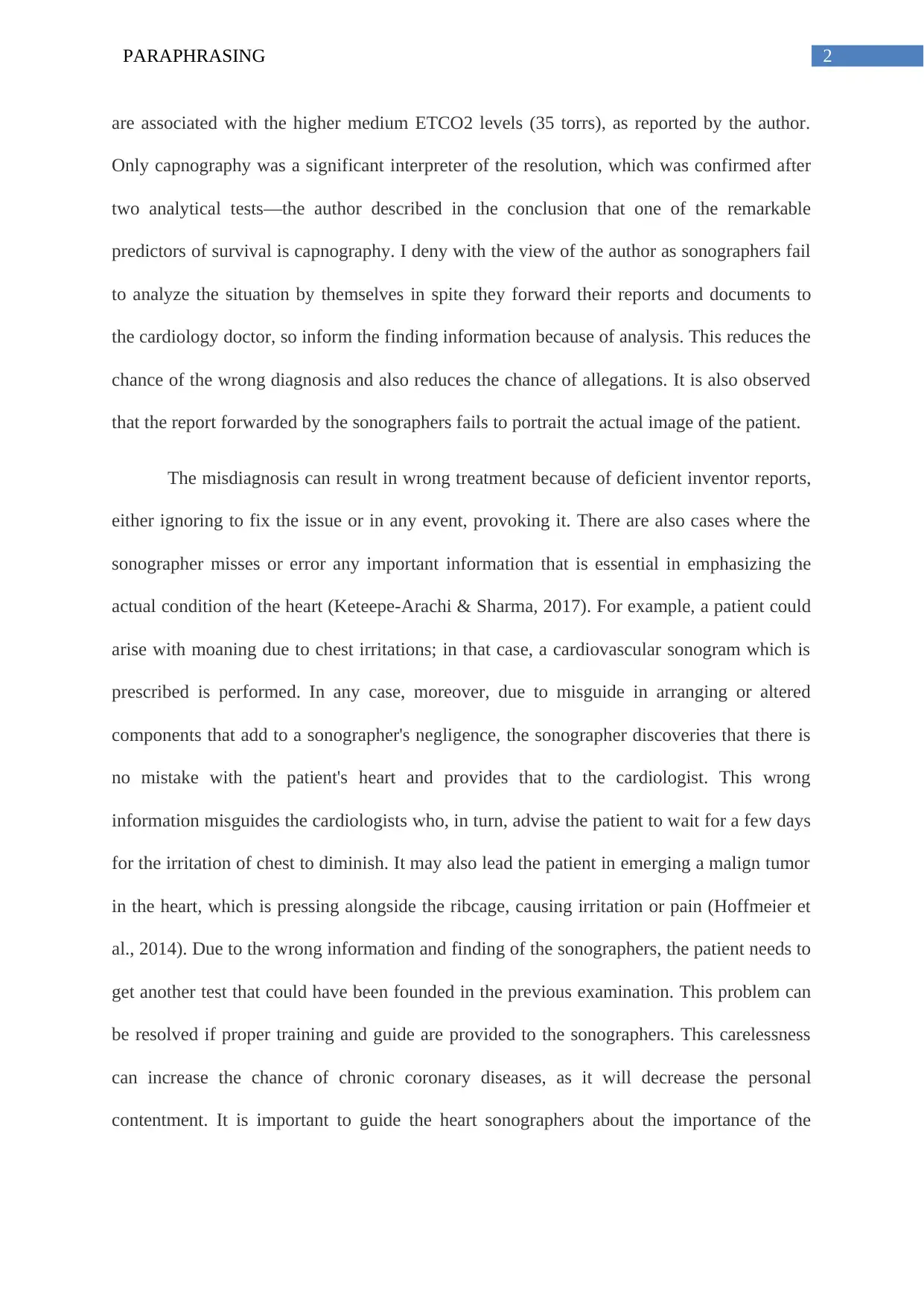
2PARAPHRASING
are associated with the higher medium ETCO2 levels (35 torrs), as reported by the author.
Only capnography was a significant interpreter of the resolution, which was confirmed after
two analytical tests—the author described in the conclusion that one of the remarkable
predictors of survival is capnography. I deny with the view of the author as sonographers fail
to analyze the situation by themselves in spite they forward their reports and documents to
the cardiology doctor, so inform the finding information because of analysis. This reduces the
chance of the wrong diagnosis and also reduces the chance of allegations. It is also observed
that the report forwarded by the sonographers fails to portrait the actual image of the patient.
The misdiagnosis can result in wrong treatment because of deficient inventor reports,
either ignoring to fix the issue or in any event, provoking it. There are also cases where the
sonographer misses or error any important information that is essential in emphasizing the
actual condition of the heart (Keteepe-Arachi & Sharma, 2017). For example, a patient could
arise with moaning due to chest irritations; in that case, a cardiovascular sonogram which is
prescribed is performed. In any case, moreover, due to misguide in arranging or altered
components that add to a sonographer's negligence, the sonographer discoveries that there is
no mistake with the patient's heart and provides that to the cardiologist. This wrong
information misguides the cardiologists who, in turn, advise the patient to wait for a few days
for the irritation of chest to diminish. It may also lead the patient in emerging a malign tumor
in the heart, which is pressing alongside the ribcage, causing irritation or pain (Hoffmeier et
al., 2014). Due to the wrong information and finding of the sonographers, the patient needs to
get another test that could have been founded in the previous examination. This problem can
be resolved if proper training and guide are provided to the sonographers. This carelessness
can increase the chance of chronic coronary diseases, as it will decrease the personal
contentment. It is important to guide the heart sonographers about the importance of the
are associated with the higher medium ETCO2 levels (35 torrs), as reported by the author.
Only capnography was a significant interpreter of the resolution, which was confirmed after
two analytical tests—the author described in the conclusion that one of the remarkable
predictors of survival is capnography. I deny with the view of the author as sonographers fail
to analyze the situation by themselves in spite they forward their reports and documents to
the cardiology doctor, so inform the finding information because of analysis. This reduces the
chance of the wrong diagnosis and also reduces the chance of allegations. It is also observed
that the report forwarded by the sonographers fails to portrait the actual image of the patient.
The misdiagnosis can result in wrong treatment because of deficient inventor reports,
either ignoring to fix the issue or in any event, provoking it. There are also cases where the
sonographer misses or error any important information that is essential in emphasizing the
actual condition of the heart (Keteepe-Arachi & Sharma, 2017). For example, a patient could
arise with moaning due to chest irritations; in that case, a cardiovascular sonogram which is
prescribed is performed. In any case, moreover, due to misguide in arranging or altered
components that add to a sonographer's negligence, the sonographer discoveries that there is
no mistake with the patient's heart and provides that to the cardiologist. This wrong
information misguides the cardiologists who, in turn, advise the patient to wait for a few days
for the irritation of chest to diminish. It may also lead the patient in emerging a malign tumor
in the heart, which is pressing alongside the ribcage, causing irritation or pain (Hoffmeier et
al., 2014). Due to the wrong information and finding of the sonographers, the patient needs to
get another test that could have been founded in the previous examination. This problem can
be resolved if proper training and guide are provided to the sonographers. This carelessness
can increase the chance of chronic coronary diseases, as it will decrease the personal
contentment. It is important to guide the heart sonographers about the importance of the
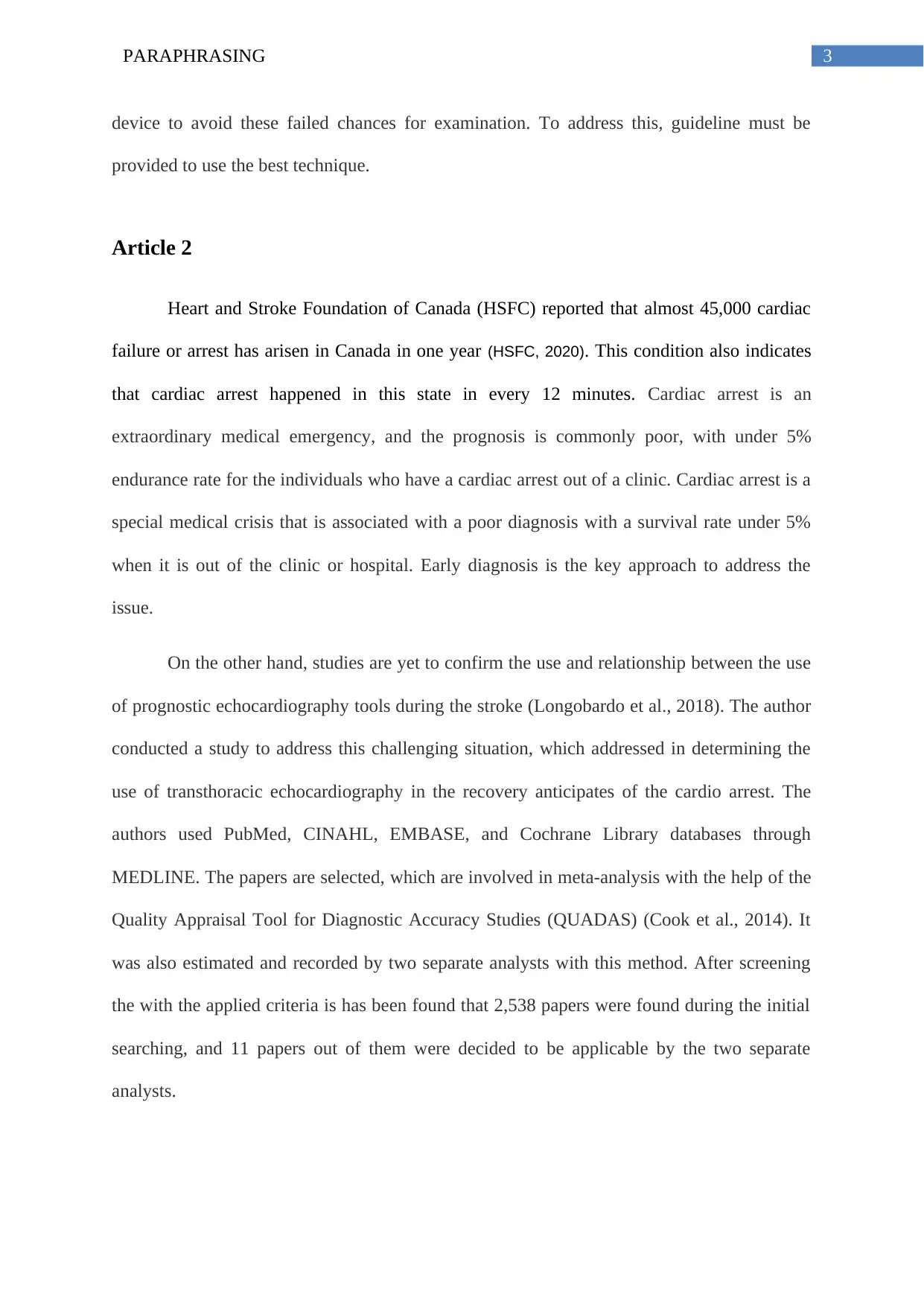
3PARAPHRASING
device to avoid these failed chances for examination. To address this, guideline must be
provided to use the best technique.
Article 2
Heart and Stroke Foundation of Canada (HSFC) reported that almost 45,000 cardiac
failure or arrest has arisen in Canada in one year (HSFC, 2020). This condition also indicates
that cardiac arrest happened in this state in every 12 minutes. Cardiac arrest is an
extraordinary medical emergency, and the prognosis is commonly poor, with under 5%
endurance rate for the individuals who have a cardiac arrest out of a clinic. Cardiac arrest is a
special medical crisis that is associated with a poor diagnosis with a survival rate under 5%
when it is out of the clinic or hospital. Early diagnosis is the key approach to address the
issue.
On the other hand, studies are yet to confirm the use and relationship between the use
of prognostic echocardiography tools during the stroke (Longobardo et al., 2018). The author
conducted a study to address this challenging situation, which addressed in determining the
use of transthoracic echocardiography in the recovery anticipates of the cardio arrest. The
authors used PubMed, CINAHL, EMBASE, and Cochrane Library databases through
MEDLINE. The papers are selected, which are involved in meta-analysis with the help of the
Quality Appraisal Tool for Diagnostic Accuracy Studies (QUADAS) (Cook et al., 2014). It
was also estimated and recorded by two separate analysts with this method. After screening
the with the applied criteria is has been found that 2,538 papers were found during the initial
searching, and 11 papers out of them were decided to be applicable by the two separate
analysts.
device to avoid these failed chances for examination. To address this, guideline must be
provided to use the best technique.
Article 2
Heart and Stroke Foundation of Canada (HSFC) reported that almost 45,000 cardiac
failure or arrest has arisen in Canada in one year (HSFC, 2020). This condition also indicates
that cardiac arrest happened in this state in every 12 minutes. Cardiac arrest is an
extraordinary medical emergency, and the prognosis is commonly poor, with under 5%
endurance rate for the individuals who have a cardiac arrest out of a clinic. Cardiac arrest is a
special medical crisis that is associated with a poor diagnosis with a survival rate under 5%
when it is out of the clinic or hospital. Early diagnosis is the key approach to address the
issue.
On the other hand, studies are yet to confirm the use and relationship between the use
of prognostic echocardiography tools during the stroke (Longobardo et al., 2018). The author
conducted a study to address this challenging situation, which addressed in determining the
use of transthoracic echocardiography in the recovery anticipates of the cardio arrest. The
authors used PubMed, CINAHL, EMBASE, and Cochrane Library databases through
MEDLINE. The papers are selected, which are involved in meta-analysis with the help of the
Quality Appraisal Tool for Diagnostic Accuracy Studies (QUADAS) (Cook et al., 2014). It
was also estimated and recorded by two separate analysts with this method. After screening
the with the applied criteria is has been found that 2,538 papers were found during the initial
searching, and 11 papers out of them were decided to be applicable by the two separate
analysts.
Secure Best Marks with AI Grader
Need help grading? Try our AI Grader for instant feedback on your assignments.
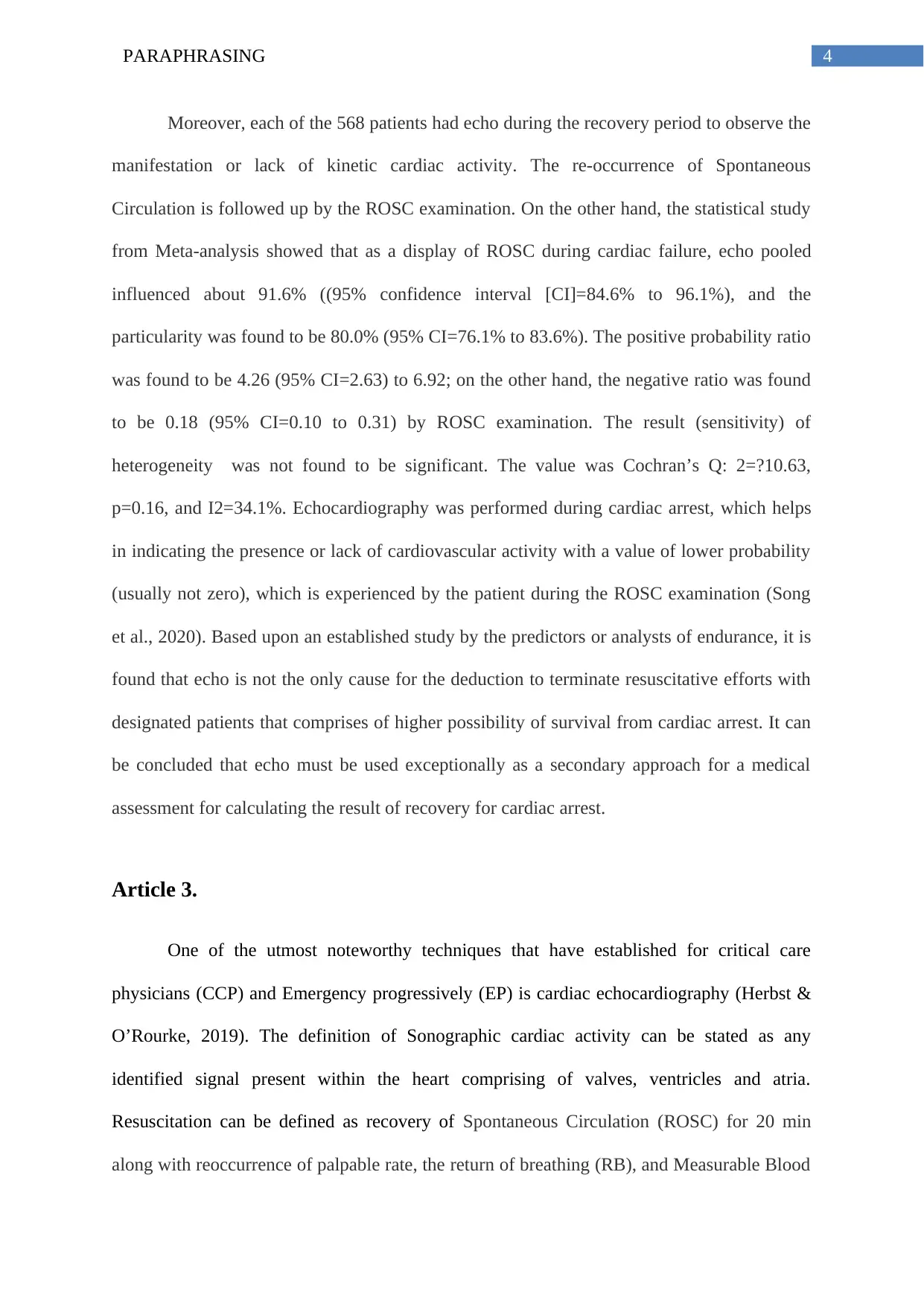
4PARAPHRASING
Moreover, each of the 568 patients had echo during the recovery period to observe the
manifestation or lack of kinetic cardiac activity. The re-occurrence of Spontaneous
Circulation is followed up by the ROSC examination. On the other hand, the statistical study
from Meta-analysis showed that as a display of ROSC during cardiac failure, echo pooled
influenced about 91.6% ((95% confidence interval [CI]=84.6% to 96.1%), and the
particularity was found to be 80.0% (95% CI=76.1% to 83.6%). The positive probability ratio
was found to be 4.26 (95% CI=2.63) to 6.92; on the other hand, the negative ratio was found
to be 0.18 (95% CI=0.10 to 0.31) by ROSC examination. The result (sensitivity) of
heterogeneity was not found to be significant. The value was Cochran’s Q: 2=?10.63,
p=0.16, and I2=34.1%. Echocardiography was performed during cardiac arrest, which helps
in indicating the presence or lack of cardiovascular activity with a value of lower probability
(usually not zero), which is experienced by the patient during the ROSC examination (Song
et al., 2020). Based upon an established study by the predictors or analysts of endurance, it is
found that echo is not the only cause for the deduction to terminate resuscitative efforts with
designated patients that comprises of higher possibility of survival from cardiac arrest. It can
be concluded that echo must be used exceptionally as a secondary approach for a medical
assessment for calculating the result of recovery for cardiac arrest.
Article 3.
One of the utmost noteworthy techniques that have established for critical care
physicians (CCP) and Emergency progressively (EP) is cardiac echocardiography (Herbst &
O’Rourke, 2019). The definition of Sonographic cardiac activity can be stated as any
identified signal present within the heart comprising of valves, ventricles and atria.
Resuscitation can be defined as recovery of Spontaneous Circulation (ROSC) for 20 min
along with reoccurrence of palpable rate, the return of breathing (RB), and Measurable Blood
Moreover, each of the 568 patients had echo during the recovery period to observe the
manifestation or lack of kinetic cardiac activity. The re-occurrence of Spontaneous
Circulation is followed up by the ROSC examination. On the other hand, the statistical study
from Meta-analysis showed that as a display of ROSC during cardiac failure, echo pooled
influenced about 91.6% ((95% confidence interval [CI]=84.6% to 96.1%), and the
particularity was found to be 80.0% (95% CI=76.1% to 83.6%). The positive probability ratio
was found to be 4.26 (95% CI=2.63) to 6.92; on the other hand, the negative ratio was found
to be 0.18 (95% CI=0.10 to 0.31) by ROSC examination. The result (sensitivity) of
heterogeneity was not found to be significant. The value was Cochran’s Q: 2=?10.63,
p=0.16, and I2=34.1%. Echocardiography was performed during cardiac arrest, which helps
in indicating the presence or lack of cardiovascular activity with a value of lower probability
(usually not zero), which is experienced by the patient during the ROSC examination (Song
et al., 2020). Based upon an established study by the predictors or analysts of endurance, it is
found that echo is not the only cause for the deduction to terminate resuscitative efforts with
designated patients that comprises of higher possibility of survival from cardiac arrest. It can
be concluded that echo must be used exceptionally as a secondary approach for a medical
assessment for calculating the result of recovery for cardiac arrest.
Article 3.
One of the utmost noteworthy techniques that have established for critical care
physicians (CCP) and Emergency progressively (EP) is cardiac echocardiography (Herbst &
O’Rourke, 2019). The definition of Sonographic cardiac activity can be stated as any
identified signal present within the heart comprising of valves, ventricles and atria.
Resuscitation can be defined as recovery of Spontaneous Circulation (ROSC) for 20 min
along with reoccurrence of palpable rate, the return of breathing (RB), and Measurable Blood

5PARAPHRASING
Pressure (MBP) (Song et al., 2020). It is also found to be deficient in the information that the
current ultrasound invention, which is packed in minor and gradually suitable units which
were effectively proved in the recent time period, to take into justification the execution of
fixated echocardiography in the whole safety of the experimental clinical parts. The author of
the paper conducted the study of eventual follow-up examination in order to identify the
capability of cardiac ultrasonography, which is used by the emergency doctors to identify the
recovery effect in grown-up patients who were previously cardiac arrested. The
ultrasonographic method was used by the authors to discourse the research questions.
Ultrasonography is an examination of the cardiac area, especially the subxiphoid region,
which is immediately measured by the physicians during the immediate visit in the
emergency department with pulseless cardiac arrest. The author defined the sonographic
cardiac activity as any spotted movement in the heart, which includes the ventricles, valves
and atria. The author defined the successful retrieval as the return of spontaneous circulation
for a period of 20 minutes, along with the return of normal breathing, assessable blood
pressure and palpable pulse rate. The files were collected for a patient who ached from CPA
and was admitted to Kayseri Training and Research Hospital in the year 2011. The
information was evaluated with hindsight by using the clinic evidence administration system.
The author included whose patients who had cardiac ultrasound and electrocardiogram
documented and executed. The performing emergency doctors were mailed with 154 surveys.
One hundred and sixteen reviews (75%) were reverted by the respondents. A maximum of
participants (60%) conveyed that they had used ultrasound at least 10 times in the course of
cardiac arrest. The author aimed at searching the reoccurring reason for cardiac arrest, also
termed as (Pericardial effusion). The report stated that 31% of people used the ultrasound
technique, which caused as an aid in critical to regulating resuscitative efforts. 59% of people
Pressure (MBP) (Song et al., 2020). It is also found to be deficient in the information that the
current ultrasound invention, which is packed in minor and gradually suitable units which
were effectively proved in the recent time period, to take into justification the execution of
fixated echocardiography in the whole safety of the experimental clinical parts. The author of
the paper conducted the study of eventual follow-up examination in order to identify the
capability of cardiac ultrasonography, which is used by the emergency doctors to identify the
recovery effect in grown-up patients who were previously cardiac arrested. The
ultrasonographic method was used by the authors to discourse the research questions.
Ultrasonography is an examination of the cardiac area, especially the subxiphoid region,
which is immediately measured by the physicians during the immediate visit in the
emergency department with pulseless cardiac arrest. The author defined the sonographic
cardiac activity as any spotted movement in the heart, which includes the ventricles, valves
and atria. The author defined the successful retrieval as the return of spontaneous circulation
for a period of 20 minutes, along with the return of normal breathing, assessable blood
pressure and palpable pulse rate. The files were collected for a patient who ached from CPA
and was admitted to Kayseri Training and Research Hospital in the year 2011. The
information was evaluated with hindsight by using the clinic evidence administration system.
The author included whose patients who had cardiac ultrasound and electrocardiogram
documented and executed. The performing emergency doctors were mailed with 154 surveys.
One hundred and sixteen reviews (75%) were reverted by the respondents. A maximum of
participants (60%) conveyed that they had used ultrasound at least 10 times in the course of
cardiac arrest. The author aimed at searching the reoccurring reason for cardiac arrest, also
termed as (Pericardial effusion). The report stated that 31% of people used the ultrasound
technique, which caused as an aid in critical to regulating resuscitative efforts. 59% of people

6PARAPHRASING
assumed that it reduced their resuscitation time. The report by the authors also stated that
only 53% of people use this ultrasound in their daily medical practice.
On the other hand, these individuals (60%) used this technique more than 50% times
during the practice. The report states that ultrasounds are beneficial in lowering the time of
code (63%) along with approving and providing assurance about the existence of cardiac
cessation for the physician and recovery team (59%). Moreover, the study included patients
(149) with more than 18 months. The report stated that the sonographic cardiac action during
the initiation of recovery was considerably related to a positive consequence [70.4%] against
[45.1%] patients deprived of cardiac activity at the commencement of resuscitation. The
report by the author also stated that there was a total of 410 patients who were involved in the
research. The authors investigated the cardiac rhythm of the patients on appearance. The data
included that 70.7% of a patient suffering from asystole, 75 (18.3%) patients reported having
a pulseless electrical activity (PEA), and 45(11%) patients had ventricular
fibrillation/pulseless ventricular tachycardia (VF/PVT) out of total 290 patients. It is also
reported that 24-hour endurance races of the groups that the cardiac activity was identified
with USG on arrival to the Emergency Department were: 35 patients in VF/PVT, two patients
in the asystole group, and 44 patients in PEA group.
assumed that it reduced their resuscitation time. The report by the authors also stated that
only 53% of people use this ultrasound in their daily medical practice.
On the other hand, these individuals (60%) used this technique more than 50% times
during the practice. The report states that ultrasounds are beneficial in lowering the time of
code (63%) along with approving and providing assurance about the existence of cardiac
cessation for the physician and recovery team (59%). Moreover, the study included patients
(149) with more than 18 months. The report stated that the sonographic cardiac action during
the initiation of recovery was considerably related to a positive consequence [70.4%] against
[45.1%] patients deprived of cardiac activity at the commencement of resuscitation. The
report by the author also stated that there was a total of 410 patients who were involved in the
research. The authors investigated the cardiac rhythm of the patients on appearance. The data
included that 70.7% of a patient suffering from asystole, 75 (18.3%) patients reported having
a pulseless electrical activity (PEA), and 45(11%) patients had ventricular
fibrillation/pulseless ventricular tachycardia (VF/PVT) out of total 290 patients. It is also
reported that 24-hour endurance races of the groups that the cardiac activity was identified
with USG on arrival to the Emergency Department were: 35 patients in VF/PVT, two patients
in the asystole group, and 44 patients in PEA group.
Paraphrase This Document
Need a fresh take? Get an instant paraphrase of this document with our AI Paraphraser
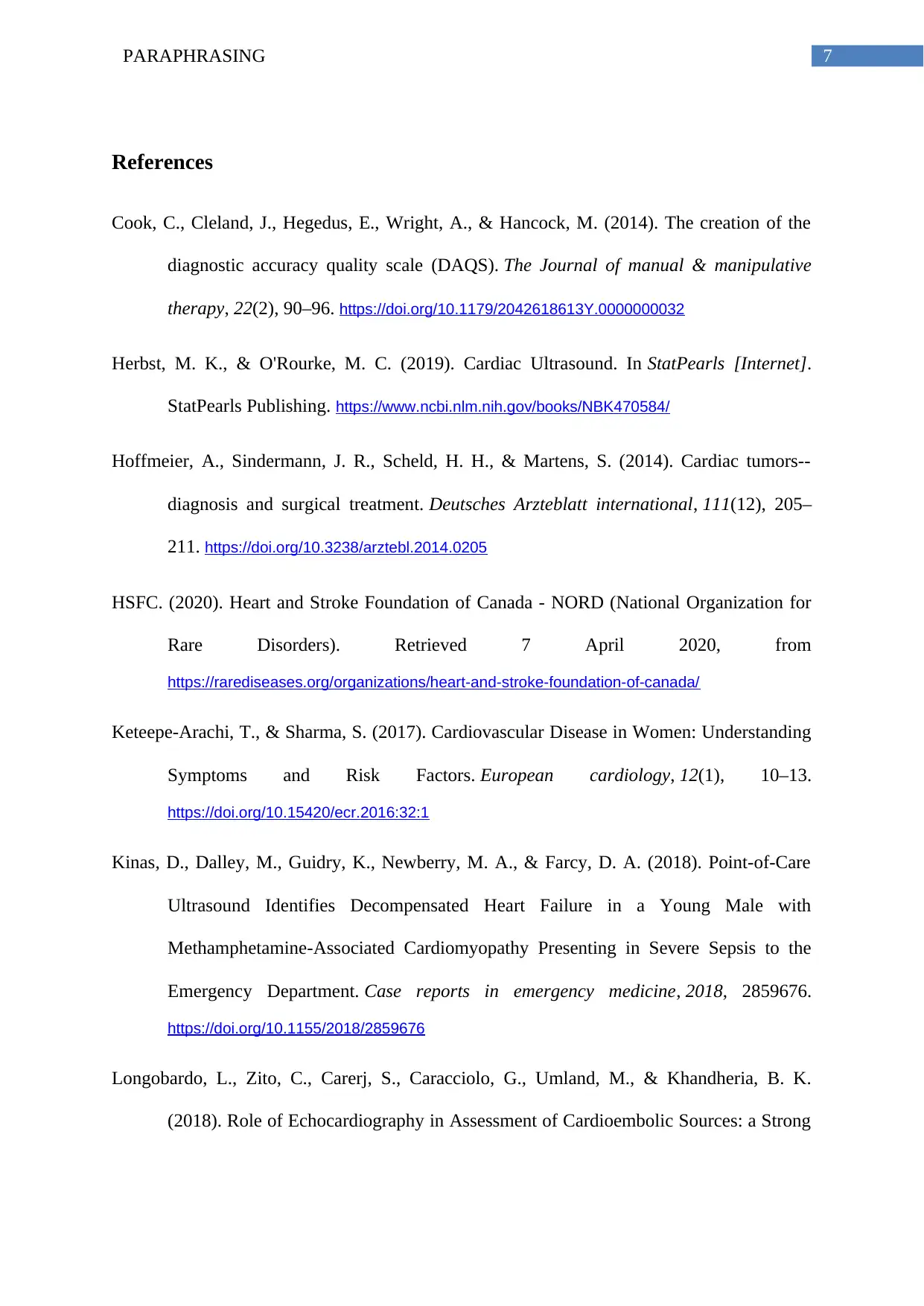
7PARAPHRASING
References
Cook, C., Cleland, J., Hegedus, E., Wright, A., & Hancock, M. (2014). The creation of the
diagnostic accuracy quality scale (DAQS). The Journal of manual & manipulative
therapy, 22(2), 90–96. https://doi.org/10.1179/2042618613Y.0000000032
Herbst, M. K., & O'Rourke, M. C. (2019). Cardiac Ultrasound. In StatPearls [Internet].
StatPearls Publishing. https://www.ncbi.nlm.nih.gov/books/NBK470584/
Hoffmeier, A., Sindermann, J. R., Scheld, H. H., & Martens, S. (2014). Cardiac tumors--
diagnosis and surgical treatment. Deutsches Arzteblatt international, 111(12), 205–
211. https://doi.org/10.3238/arztebl.2014.0205
HSFC. (2020). Heart and Stroke Foundation of Canada - NORD (National Organization for
Rare Disorders). Retrieved 7 April 2020, from
https://rarediseases.org/organizations/heart-and-stroke-foundation-of-canada/
Keteepe-Arachi, T., & Sharma, S. (2017). Cardiovascular Disease in Women: Understanding
Symptoms and Risk Factors. European cardiology, 12(1), 10–13.
https://doi.org/10.15420/ecr.2016:32:1
Kinas, D., Dalley, M., Guidry, K., Newberry, M. A., & Farcy, D. A. (2018). Point-of-Care
Ultrasound Identifies Decompensated Heart Failure in a Young Male with
Methamphetamine-Associated Cardiomyopathy Presenting in Severe Sepsis to the
Emergency Department. Case reports in emergency medicine, 2018, 2859676.
https://doi.org/10.1155/2018/2859676
Longobardo, L., Zito, C., Carerj, S., Caracciolo, G., Umland, M., & Khandheria, B. K.
(2018). Role of Echocardiography in Assessment of Cardioembolic Sources: a Strong
References
Cook, C., Cleland, J., Hegedus, E., Wright, A., & Hancock, M. (2014). The creation of the
diagnostic accuracy quality scale (DAQS). The Journal of manual & manipulative
therapy, 22(2), 90–96. https://doi.org/10.1179/2042618613Y.0000000032
Herbst, M. K., & O'Rourke, M. C. (2019). Cardiac Ultrasound. In StatPearls [Internet].
StatPearls Publishing. https://www.ncbi.nlm.nih.gov/books/NBK470584/
Hoffmeier, A., Sindermann, J. R., Scheld, H. H., & Martens, S. (2014). Cardiac tumors--
diagnosis and surgical treatment. Deutsches Arzteblatt international, 111(12), 205–
211. https://doi.org/10.3238/arztebl.2014.0205
HSFC. (2020). Heart and Stroke Foundation of Canada - NORD (National Organization for
Rare Disorders). Retrieved 7 April 2020, from
https://rarediseases.org/organizations/heart-and-stroke-foundation-of-canada/
Keteepe-Arachi, T., & Sharma, S. (2017). Cardiovascular Disease in Women: Understanding
Symptoms and Risk Factors. European cardiology, 12(1), 10–13.
https://doi.org/10.15420/ecr.2016:32:1
Kinas, D., Dalley, M., Guidry, K., Newberry, M. A., & Farcy, D. A. (2018). Point-of-Care
Ultrasound Identifies Decompensated Heart Failure in a Young Male with
Methamphetamine-Associated Cardiomyopathy Presenting in Severe Sepsis to the
Emergency Department. Case reports in emergency medicine, 2018, 2859676.
https://doi.org/10.1155/2018/2859676
Longobardo, L., Zito, C., Carerj, S., Caracciolo, G., Umland, M., & Khandheria, B. K.
(2018). Role of Echocardiography in Assessment of Cardioembolic Sources: a Strong
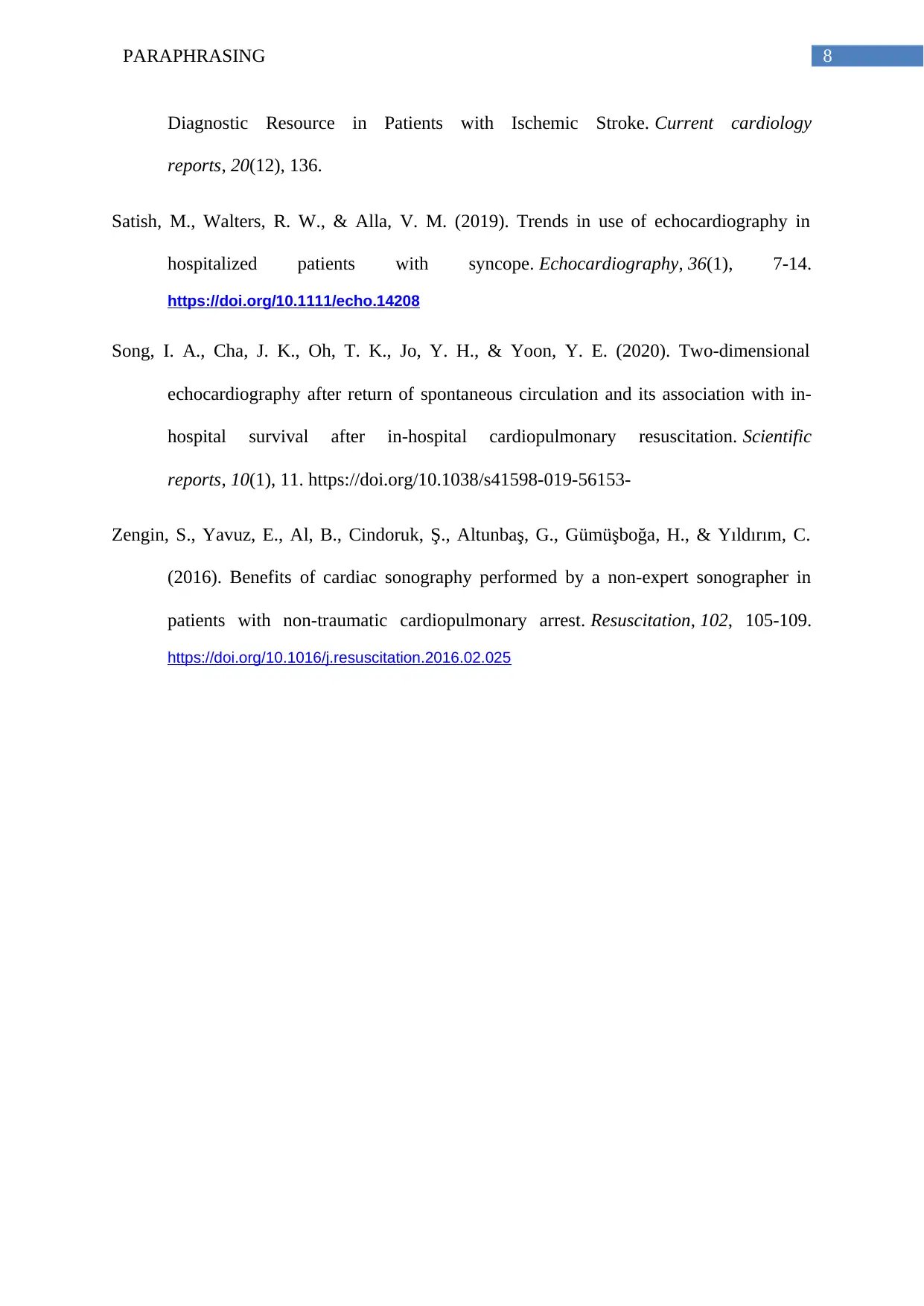
8PARAPHRASING
Diagnostic Resource in Patients with Ischemic Stroke. Current cardiology
reports, 20(12), 136.
Satish, M., Walters, R. W., & Alla, V. M. (2019). Trends in use of echocardiography in
hospitalized patients with syncope. Echocardiography, 36(1), 7-14.
https://doi.org/10.1111/echo.14208
Song, I. A., Cha, J. K., Oh, T. K., Jo, Y. H., & Yoon, Y. E. (2020). Two-dimensional
echocardiography after return of spontaneous circulation and its association with in-
hospital survival after in-hospital cardiopulmonary resuscitation. Scientific
reports, 10(1), 11. https://doi.org/10.1038/s41598-019-56153-
Zengin, S., Yavuz, E., Al, B., Cindoruk, Ş., Altunbaş, G., Gümüşboğa, H., & Yıldırım, C.
(2016). Benefits of cardiac sonography performed by a non-expert sonographer in
patients with non-traumatic cardiopulmonary arrest. Resuscitation, 102, 105-109.
https://doi.org/10.1016/j.resuscitation.2016.02.025
Diagnostic Resource in Patients with Ischemic Stroke. Current cardiology
reports, 20(12), 136.
Satish, M., Walters, R. W., & Alla, V. M. (2019). Trends in use of echocardiography in
hospitalized patients with syncope. Echocardiography, 36(1), 7-14.
https://doi.org/10.1111/echo.14208
Song, I. A., Cha, J. K., Oh, T. K., Jo, Y. H., & Yoon, Y. E. (2020). Two-dimensional
echocardiography after return of spontaneous circulation and its association with in-
hospital survival after in-hospital cardiopulmonary resuscitation. Scientific
reports, 10(1), 11. https://doi.org/10.1038/s41598-019-56153-
Zengin, S., Yavuz, E., Al, B., Cindoruk, Ş., Altunbaş, G., Gümüşboğa, H., & Yıldırım, C.
(2016). Benefits of cardiac sonography performed by a non-expert sonographer in
patients with non-traumatic cardiopulmonary arrest. Resuscitation, 102, 105-109.
https://doi.org/10.1016/j.resuscitation.2016.02.025
1 out of 9
Your All-in-One AI-Powered Toolkit for Academic Success.
+13062052269
info@desklib.com
Available 24*7 on WhatsApp / Email
![[object Object]](/_next/static/media/star-bottom.7253800d.svg)
Unlock your academic potential
© 2024 | Zucol Services PVT LTD | All rights reserved.
